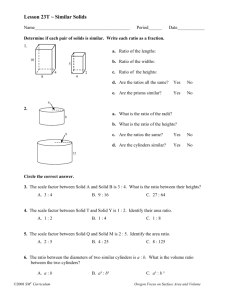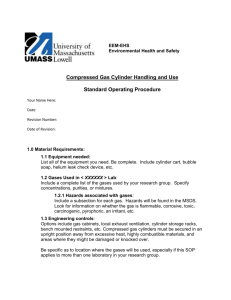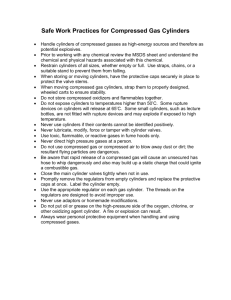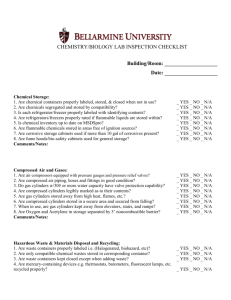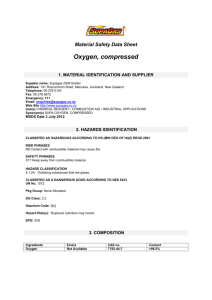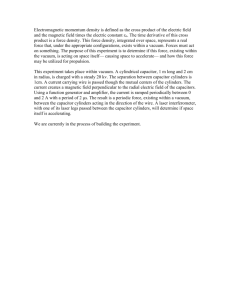Bolton Metropolitan Borough Council
advertisement
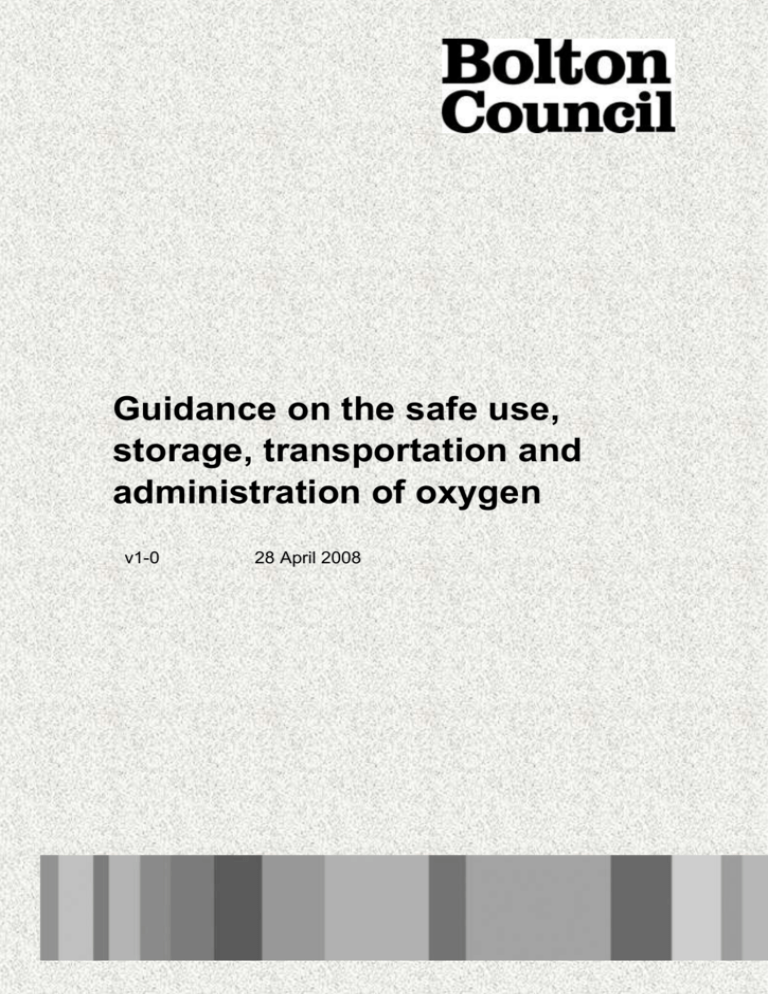
Guidance on the safe use, storage, transportation and administration of oxygen v1-0 28 April 2008 CONTENTS Page Nos 1. Introduction 1 2. Oxygen therapy 1 3. Responsibilities 2 4. Use of oxygen by service user 3 5. Administration of oxygen by employees 3 6. Transport of oxygen cylinders 7. Risk assessment 6 8. Review 6 References 6 1. Safety Guidance – Oxygen use 4&5 7&8 1. Introduction This document provides information and guidance on: the supplier; arrangements in place for transition from pharmacy suppliers how oxygen is prescribed provision of oxygen equipment use of oxygen by service users administration of oxygen by employees transport of oxygen cylinders Risk Assessment and Service User Risk Assessment guidelines on the safe use of oxygen equipment Storage of cylinders and fire. It is applicable to all areas of service delivery and should be followed as good practice by the independent sector. 2. Oxygen therapy 2.1 Supplier of oxygen equipment Air Products Limited has the contract to supply oxygen therapy equipment for service users living in their own home or in residential care. 2.2 Prescription of oxygen therapy Oxygen is prescribed and ordered initially by a Registered Health Care Professional (e.g. District Nurse) who will complete a Home Oxygen Order Form (HOOF) which will be faxed to Air Products Ltd. If an emergency order is placed, this must be followed up by a standard HOOF. Replacement cylinders can then be ordered by telephone without the need for a further order form, which will only be required if the service user’s needs change. 2.3 Provision of oxygen equipment Anyone using oxygen for more than 2 hours each day will be supplied with a concentrator instead of oxygen cylinders, although one oxygen cylinder will be supplied as back up for use in the event of equipment or power failure. The supplier will deliver and install the appropriate equipment, complete a risk assessment for their own records and provide training for the service user. Training will also be provided for carers if required. The oxygen flow rate will be set to the level prescribed and must not be altered by care staff or the service user. If a concentrator is used, the setting can be locked by the supplier. The supplier will leave a folder with the service user containing information, instructions for use and guidance on the safe use of oxygen. If additional copies are required, booklets Page 1 of 9 can be downloaded from the Air Products website. Where concentrators are supplied, these will be serviced by the supplier every 6 months. The service user/care staff must remove the filter and wash it once a week, in accordance with the manufacturer’s instructions. 2.4 Replacement cylinders The service user is responsible for ordering replacement cylinders, either via the Pharmacist or by a telephone call to Air Products on 0800 373580 and is required to give the supplier 3 working days notice. If the service user is unable to arrange replacement cylinders, or is a resident in a care home, an employee must monitor oxygen usage and reorder when the service user is on the second to last cylinder, giving 3 working days notice. A record of the oxygen prescription and replacement cylinders must be made using the medication administration sheet. 2.5 Ambulatory Oxygen Small cylinders may be provided for service users who are mobile to enable them to travel outside the home. Full information and training will be provided by the supplier for this equipment; the leaflet “Your guide to using oxygen equipment” can be downloaded from the Air Products website. Liquid oxygen may be supplied for service users who are away from home for long periods. A large container of liquid oxygen is supplied from which the service user fills a smaller, portable unit – it is unlikely that this type of equipment will be issued to people receiving residential social care. 3. Responsibilities 3.1 Heads of Service Heads of Service are responsible for ensuring that this guidance is disseminated to Managers via their Management Team Meetings and for monitoring the implementation of the procedures outlined below. 3.2 Team Leaders/Operational Managers Managers must ensure that all employees are briefed on the contents of this guidance; that appropriate risk assessments are completed and that suitable information, instruction and training is carried out. 3.3 Care Managers Care Managers must ensure that all agencies are informed of the requirement to follow these guidelines when they are providing support for a service user who uses oxygen. The Service User Risk Assessment must include the use of oxygen and steps required to reduce risk. Page 2 of 8 3.4. All employees supporting service users who use oxygen All employees must work with service users to ensure that they use their oxygen equipment safely. They must follow the procedures identified for administration of oxygen and ordering replacement cylinders if appropriate. Employees must report any concerns immediately to their line manager, the service user’s GP or Air Products as appropriate and record their action on the service user’s personal record. All incidents involving oxygen administration must be reported on an accident report form and forwarded to the Occupational Safety & Health Shared Service - OSHSS. The unit is located on the 2nd floor, Paderborn House tel: 01204 331210. 4. Use of oxygen by service user Individuals may be prescribed oxygen for either 24 hour use or occasional use as required. Service users should, wherever possible, administer their own oxygen following training from the supplier. It is not usually part of the role of domiciliary support staff to administer oxygen. However, they must be aware of the guidance for safe use of oxygen in order to remind clients to operate the equipment safely and minimise risks to themselves and others. They must know what to do in an emergency, as set out below and must raise any concerns with their line manager or out of hours staff, who will liaise with the GP or supplier if necessary. If a Service User is known to use oxygen at home but indicates that they can attend day care or respite care without oxygen, then confirmation must be obtained from the GP that this is acceptable, in writing if possible, or a note of the telephone conversation must be recorded on the Care Plan. 5. Administration of oxygen by employees Before a service user who uses oxygen can be accepted for residential care, the Manager must ensure that employees have received training and that there is appropriate storage for cylinders. If it is necessary for employees to administer oxygen to a service user it must only be done under the following circumstances: The method and amount of oxygen to be delivered to the service user must be clearly prescribed by the relevant NHS Trust in writing. This must match the instructions from the supplier responsible for delivering the oxygen equipment. Under no circumstances can instructions be accepted only from a parent/carer, or accepted verbally. In all other respects the receipt of oxygen into the premises must be treated in the same way as medication. All employees who are required to administer oxygen must be trained by the supplier or a Community Nurse. The Service Manager is responsible for arranging training and must keep a record of all such training. Page 3 of 8 Where occasional therapy using an oxygen cylinder is required, a trained employee must be responsible for administering and monitoring the use of oxygen. Two employees must witness the numbered setting of the regulator when the oxygen is switched on. The administration must be documented on the administration of medicines sheet. Oxygen masks or canula must be kept clean and dry and must be disposed of when oxygen therapy is no longer required to prevent cross infection. Concentrators deliver oxygen at a pre-set standard rate and employees must follow instructions for use. If care is purchased from the independent sector, the Care Manager should have an assurance in writing that the carers allocated to the service user are appropriately trained and competent. Employees who have not received training MUST NOT administer oxygen. In residential establishments, there must be a sign on the doors of rooms used for administration stating that oxygen is in use. Signs can be provided by Air Products Ltd. The fire risk assessment for the premises must be updated to indicate the presence of oxygen within the building. Oxygen must only be administered in accordance with the supplier’s instructions and must never be used for other service users, except in an emergency when a qualified nurse in a residential establishment may use available equipment. A cylinder trolley must be used to enable the safe handling of oxygen cylinders. If the establishment does not have access to a trolley, then arrangements to hire one from Air Products must be made before the service commences. Cylinders must be stored, with valves closed tightly, in an upright position and chained or clamped to prevent them from falling over 6. Transport of oxygen cylinders Before a council vehicle is used to transport a person using oxygen, a full risk assessment must be completed and agreed with both the manager of the person receiving the service and the transport manager. The following precautions need to be followed: The driver of the vehicle should ascertain with the person prior to the journey commencing they are (at that time) not experiencing any breathing difficulties. A person should not be transported if they indicate (at that time) they are having breathing difficulties prior to the journey commencing. The cylinder must be securely stored during the journey – not held by the person or strapped to the chair. Page 4 of 8 A person should not use oxygen when the vehicle is in motion. The person must take responsibility to ensure that pipes/tubing associated with the use of oxygen is not allowed to encroach in the walkway of the vehicle. If the person does require oxygen, the driver must find a safe place to stop, the engine must be switched off and the windows of the vehicle opened to reduce the risk of oxygen enrichment. The driver/escort should ensure that the person has access to the oxygen. If the person’s condition improves following the use of oxygen, the windows of the vehicle can be closed 10 minutes after recovery (to ensure any build up of oxygen is ventilated) and the journey may continue. If the person does not improve from using the oxygen, the driver/escort must contact the emergency services. If a person requires oxygen whilst using the transport, this must be communicated to a responsible person when the individual reaches their destination and an incident form completed. The vehicle must display appropriate warning signs on the rear and off-side of the vehicle that compressed air is being carried. If a vehicle carrying an oxygen cylinder is involved in a road traffic accident requiring the attendance of emergency services, the driver must inform the emergency services that oxygen is being carried and where it is located. Copies of Material Safety Data Sheets (MSDS) should be available on the vehicle and handed over to the emergency services. Information regarding the size of cylinders and amounts of oxygen on board should also be included with the MSDS. Individual portable cylinders must be kept in the carry bag provided and secured – not held by the person. If employees are required to transport a service user with oxygen in their own car, the following guidance is applicable: A full risk assessment must be completed by the driver of the vehicle. The cylinder must be securely stored during the journey. The vehicle must display appropriate warning signs on the rear and off-side of the vehicle that compressed air is being carried. If a vehicle carrying an oxygen cylinder is involved in a road traffic accident requiring the attendance of emergency services, the driver must inform the emergency services that oxygen is being carried and where it is located. Copies of Material Safety Data Sheets (MSDS) should be available on the vehicle and handed over to the emergency services. Information regarding the size of cylinders and amounts of oxygen on board should also be included with the MSDS. Individual portable cylinders must be kept in the carry bag provided and secured. Page 5 of 8 7. Risk assessment 7.1 General Risk Assessments Employers are legally required to assess risks in the workplace and take all reasonable precautions to ensure the safety of employees and members of the public. A general risk assessment must be completed for the use of oxygen for every establishment or service area where oxygen may be used and information provided for all employees on safe working practices. 7.2 Service User Risk Assessment The Service User Risk Assessment must include the use of oxygen if appropriate and the service manager must ensure that a copy of the safety guidance contained in Appendix 1 is available for employee reference in all locations where oxygen is used. 7.3 Fire Risk Assessment The storage and use of Oxygen cylinders must be included on the Fire Risk Assessment of the premises in which it is being used/stored and appropriate signage affixed - available from Air Products. 8. Review General and Service User Risk Assessments must be reviewed by service managers/care managers when required. This document will be reviewed if there is a change to the way oxygen is provided for service users in the community. References Guidance from: www.airproducts.co.uk Page 6 of 8 Appendix 1 Safety guidance – oxygen use General: Oxygen is not explosive but it will help fires to burn more fiercely. Oxygen can be absorbed into the clothing and furnishings surrounding the user, and excessive levels of oxygen will cause substances to ignite more easily and burn more fiercely. Oxygen equipment must be switched off when not in use. Do not smoke, or allow others to smoke, while oxygen is being used. If a service user is suspected of smoking, then they must be referred back to their GP. When using oxygen do not leave the mask or canula lying on the bed or chair for any length of time – oxygen may build up, or saturate the material and make it more flammable. If saturation occurs, the area should be ventilated by opening windows and doors for at least 30 minutes. All oxygen equipment must be kept well away from sources of heat, such as fires, cookers and heaters, etc. as well as electrical appliances such as a TV, fan, hairdryer, etc. Recommended distances for oxygen therapy equipment: Open fires etc – 3 metres; Closed fires e.g. heating sources – 1.5 metres. If a service user needs to cook while receiving oxygen, electric or microwave ovens do not present a problem. Oxygen should never be used near an open flame like a gas cooker or fire. Only use oxygen equipment in a well ventilated area – keep internal doors open whilst the equipment is in use. Do not use oil or grease on oxygen equipment including alcohol hand gels. Ensure your hands are clean and dry when handling equipment. Do not let children or untrained people tamper with oxygen equipment Oxygen Concentrators: Never place an oxygen concentrator near curtains or cover with clothing as this will restrict air circulation. A concentrator purifies air from the surroundings – if it is used near heaters or fires, fumes from the air may not be completely removed. A gap of 15 cm should be left around a concentrator to ensure adequate ventilation. It should be kept away from upholstery and any other material surfaces. The concentrator should be located where the built-in alarm can be heard. Page 7 of 8 Oxygen Cylinders: Keep cylinders below 50oC (122oF) in a well-ventilated place Close the cylinder valve (On / Off valve) when not in use Do not cover or hang clothes on the cylinder Storage of cylinders: Cylinders should be stored in the open air where possible. If this is not reasonably practicable, then they should be stored in a well ventilated area or storeroom, the door of which should be marked with the oxygen symbol. Cylinders must not be subjected to extremes of heat or cold and must be stored away from highly flammable liquids, combustible materials, oils, greases and from sources of heat and ignition. Cylinders must be stored, with valves closed tightly, in an upright position and chained or clamped to prevent them from falling over In residential establishments, all employees must be made aware of the location of stored oxygen cylinders and be able to give this information to the Fire Service in the event of a fire. A manual handling assessment must be undertaken to determine the safe method of moving cylinders. Always ensure Air Products’ emergency number is readily available when oxygen is being used: 0800 373580 Fire Keep escape routes clear. In residential establishments, plan the location of the service user within the building to ensure that they can be safely and quickly evacuated in the event of an emergency In the event of a fire: Sound the alarm. Call the Fire Service; tell them that oxygen cylinders are on the premises. Commence evacuation of the premises in accordance with the agreed evacuation procedures. When the emergency services arrive, an employee must be available to give the location of cylinders both in use and stored. Page 8 of 8
